The mining industry is an essential industry that significantly contributes to Australia’s economic growth. Due to the hazardous and exhausting nature of the operations, it is extremely crucial to prioritize and maintain the safety standards of the mining sites and operations. It ensures the workers get home safely to their loved ones, and it prevents mine closure due to the unwanted accident which causes massive financial loss to the operators.
Regular monitoring of the health of the mining infrastructure allows the sites to achieve maximum annual productivity with minimum downtime. For example, roof collapse, fracture propagation, deformation of roof strata are some typical accidents in coal mines. Local accidents have been previously recorded in Tasmania and Queensland, including a roof collapse that halted mine operations and resulted in fatalities.
Structural failures in the underground mines are one of the challenging safety problems that needs to be avoided and immediately addressed. During the construction process, the tunnel opening in the underground mining is supported by pillars and structures. The pillar line is continually subjected to severe internal stress that over time leads to failure. In addition, the harsh environmental conditions further add to this stress which accelerates the deformation. Once the accident happens, it poses a massive safety risk and also hampers operations which result in inefficient recovery of ore reserves. Such hazardous accidents happen due to the lack of a preventive maintenance system implemented to regularly monitor the health of infrastructure in mining sites.
With time, infrastructure in mining sites wears out and needs repairs, but the costs of repairing it after it has collapsed are far greater than if it had been maintained on a regular basis. Also, workers will be less likely to be hurt or lose productivity if machines have been properly maintained. Preventive maintenance involves a scheduled inspection of mine infrastructure, equipment, and machinery to assess possible damage, prevent accidents, and ultimately ensure worker’s safety.
Strain gauges are one of the most widely used sensors in preventive maintenance systems to enable the early detection of potential structural failure. The gauges are installed on the most vulnerable location in the structure to examine its stress and strain distribution. Engineers evaluate the data and determine whether maintenance needs to be scheduled to preserve the life of the structures.
Bestech Australia supplies a wide range of strain gauges, bonding adhesives and coating materials to the industry; from general foil strain gauges to high temperature strain gauges to ensure reliable measurement under diverse conditions. They are manufactured in a clean environment and are tested according to the NAS942 and ASTM E251-74.

The strain measurements are based on the increase or decrease of resistance of the conductor due to compression or tension. Installing the strain gauges in four vertical grooves enables the measurement of axial and shear stresses. Any sudden increase in these values indicates the instability of the infrastructure.
Other than foil strain gauges, there are also many types of sensors such as accelerometers and fiber optics FBG sensors, that are commonly used and implemented for preventive maintenance in a mining site.
FBG sensors can measure strain, vibration, angle and displacement for monitoring the health of the infrastructure. FBG strain and temperature sensors along with interrogators work as data collection units and help to acquire the complete information of the structure.
They monitor the effect of dynamic mining activity on structural stability by comparing strain variations. The system allows sharing valuable information at remote places by assessing and analyzing the collected data. This data can be recalled anytime, anywhere by authorized users. Hence, the system aids in substituting the reactive approaches of mine structural monitoring to proactive failure detection and accident prevention strategies.

The monitoring system equipped with optical strain gauges eliminates the exposure of mining professionals to harsh environmental conditions of underground mines. They boost the efficiency of the mining sites and help to minimize the overall expenses for infrastructure monitoring. In addition, by providing critical information in real-time, the system helps to predict, plan, and optimize the maintenance activities in mining sites.


